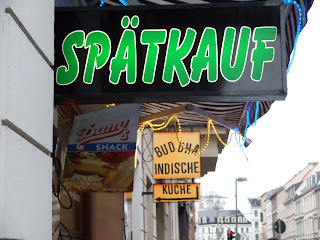When I went to the library today,
Die neue Typographie was absent from the shelf. I hope it reappears. In any case, I will attempt to answer some questions my professor posed to my post from a couple of days ago, though without any Tschichold quotations to back me up.
1. Tschichold wrote an entire section about photography, but I'm at a loss as to specifics of his argument. But, I think a good response to your question is the general view that photography is objective (which it isn't) compared to say, expressionist painting. Jan has a problem with accompanying a Modern medium like photography with Schnörkel, etc. And, I think that as a man of the Neue Sachlichkeit, he not only has faith in technological wonders, but views them as superior and more beautiful than human creation. As he wrote, order=beauty.
2. To answer the question of "Beamtenschrift," going back to the woodcut commissioned by Maximilian I is useful. You're right! Fraktur in its original form had everything to do with pictures. It was created to accompany images that the public/visitors/admirers/whoever could appreciate, while historians were probably the only ones the Kaiser expected to read the actual text. Tschichold seems to reject Fraktur precisely because of its inaccessibility, both aesthetically and historically. He believed that basic functionality was the first priority of any typeface. In that sense, Fraktur could be connected with elitism, old structures of social order, despotism, etc. Ironically, several designers interviewed in the documentary Helvetica equated the ultimate modernist sans serif, Helvetica, with war, consumerism, uniformity, oppression, etc. Functionality, by the late 20th century, came full circle to become a typographic oppressor instead of liberator. At least that's what some post-modernists said. Don't quote me on this.
3. Tschichold thought EVERYTHING should be in Grotesk. Everything.
And, finally, I think the answer to the Grotesk vs. Law question, the only answer, from the Tschichold perspective, is that words themselves are not objective, but rather their graphic representation should be (hence the sans serifs). So, I think that posing Grotesk and Law against each other is invalid because one is a typeface and the other is something the typeface represents. Feel free to shoot me down on this one.
On to my ever-exciting activities of the day:
I went to the library to see if the Berliner illustrierte Zeitung ever switched out of Fraktur during the Weimar Republic. It didn't. While I was looking, I came across an interesting tidbit that goes back to my original topic: representations of the New Woman. In an October issue of the BIZ, 1927, the cover featured an image of a woman and a man, dressed and styled almost identically with fitted sport coats, ties, slick hair, and cigarettes, walking together with figures in the background looking on and evidently making snide remarks about the woman's androgynous appearance. Inside the front cover, the Zeitung posed a question with a competition for who could come up with the wittiest answer. It was similar to the New Yorker caption contest, but mean. Here is what it said:
"Das Bild auf der Titelseite zeigt eine Zeitgestalt "Fräulein Mia," einen neuen Mädchentyp, der sich in Arbeit, Lebensführung, und Erscheinung den Mann zum Vorbild genommen hat...Was sagen Sie bloß zu Fräulein Mia? 3.000 M für die witzigsten Lösungen."
Hilarious. (Not.) Coming into this topic, I was sort of expecting to have to interpret a lot of complex imagery with many meanings reflecting different views of women, but this is pretty blatant and straightforward. It will be interesting to compare this view with images from Die Dame in 1927 and 28.
I went to the Käthe Kollwitz museum in the afternoon. I have to say, of all the art I've seen so far, hers is easily the most beautiful, in my opinion. Even her political posters feature handwritten script, which is refreshing after thinking really hard about Modernist typeface lately.
I also started reading a book by a designer named Erik Spiekermann called
Ursache & Wirkung: ein typographische Roman. To be honest, I don't really understand it. But, his basic thing is that modernists are bad because they make everything uniform, which is not the way things are. He is also just awesome, as demonstrated in
this news clip.
Even though I find Spiekermann fascinating, his super precise and technical discussion of typeface in his book sort of made me realize that I am completely unequipped to actually study typography, mostly because of my lack of background in graphic design. So, I think I might change gears a bit and try to ground my investigations in history a bit more. We'll see how that goes.
Anyway, I guess the only Richtung to head at this point is forward, which I will do by looking more at Die Dame, maybe checking out the DDR museum (the Buchstabenmuseum has gotten me super interested in relics/material implications of the fall of the DDR), and attempting to get access to the poster archive of the Deutsches Historisches Museum. That would be truly epic, as kids these days would say. In any case, stay tuned.




















































